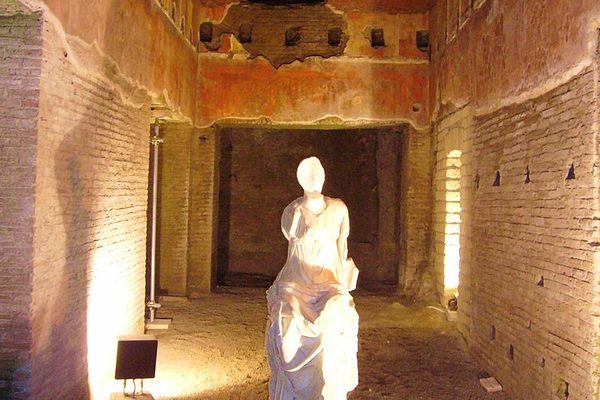Basilica of Santi Quattro Coronati
A fortified medieval basilica on the Caelian Hill preserves extraordinary frescoes and one of Rome's most beautiful hidden cloisters.
When approaching the Basilica of Santi Quattro Coronati (“Four Crowned Martyrs”) on the Caelian Hill in Rome, a bulky, thick-walled structure emerges on the way to the Lateran that looks more like a fortress than a church. Its history has indeed been tumultuous yet it’s miraculously preserved some of Rome’s most secret and impressive treasures: Saint Sylvester’s Chapel, the Gothic Hall, and a meditative, secret cloister that you might very likely have all to yourself.
The basilica’s name in itself is something of a hagiographical mystery. Were its four crowned martyrs four soldiers in the age of Diocletian who refused to sacrifice to Asclepius, the god of medicine? Or were they the five stonemasons (what happened to the fifth?) from Pannonia who refused to carve a statue of the god? Or were they four less exotic and more local martyrs from nearby Albano? In any case, what we know for certain is their crown was that of martyrdom, reason enough for their relics to be venerated in a private site known as Titulus Aemiliane that dates back to the age of Pope Miltiades in the 4th century.
Only the original apse and some underground archaeological excavations can be dated all the way back to this period, while the rest of the church was rebuilt in the 6th and 9th centuries. At this time, under Pope Leo IV, its Carolingian architecture would have been remarkable and a popular stop on the road to the Lateran Palace, the see of the papacy in those centuries.
The basilica was then ravaged by the Norman adventurer Robert Guiscard during the great sack of 1084, after which its size was reduced by Pope Paschal II and a Benedictine monastery was added. Its fortress-like appearance and odd proportions we owe to Cardinal Conti, who turned it into a sanctuary for the popes during their endless conflict with the Hohenstaufen Emperors in the troubled 13th century. Its fortified structure still survives and the massive 9th-century bell tower over the main entrance gate is the oldest of its kind in Rome.
From the main gate, the two open courtyards correspond to the actual size of the original basilica before its 11th-century reconstruction. To this age we owe one of the church’s greatest treasures, the frescoed Chapel of Saint Sylvester. A strong political statement of the age, the frescos depicts the idealised relationship between Pope Sylvester and the Christian Emperor Constantine, the key players in that medieval forged document known as the Donation of Constantine, in which the Roman Emperor, in moving his capital to Constantinople, had supposedly given temporal power over the West to the popes of Rome. The vivid images depict the apocryphal stories of Constantine’s conversion to the church, and would have served as a strong reminder to the rebellious Hohenstaufen emperors of their rightful place in Western European politics.
In later times, during the age of the papacy’s exile in Avignon, France, the basilica fell into a state of disrepair. It was finally restored in the 16th century and since then it has been entrusted to the Augustinian nuns. The second great treasure can be accessed from the church’s left nave: This is the beautiful cloister dating back from the early 1200s. This Romanesque Eden with its portico, its painted arches, its spolia, the chapel of Saint Barbara with its medieval frescoes, greenery, and central fountain make this one of the most secluded and quiet spots in the city.
The third great treasure of the basilica is the so-called Gothic Hall. Its 13th-century frescoes were discovered in 2002 under a layer of plaster that might have been added during the Black Plague and were intended to decorate one of the main halls in Conti’s Palazzo. This was probably the hall where justice was administered and it’s a rare testimony of the Gothic Age’s influence on Roman art, with its representation of the months of the year, the seasons, the liberal arts, the virtues, and much more.
Know Before You Go
Guided visits of the Gothic Hall are usually scheduled two to three days per month and must be booked on the website. Saint Sylvester's Chapel can be accessed by paying a 1 euro fee to the Augustinian nun who sits behind a drum. The cloister can be accessed from a door in the left nave of the church for a small fee. The basilica, cloister, and chapel are all open from Monday to Saturday from 10 a.m. to 11:45 a.m. and 4 p.m. to 5:45 p.m. The cloister is closed on Sundays.



























Follow us on Twitter to get the latest on the world's hidden wonders.
Like us on Facebook to get the latest on the world's hidden wonders.
Follow us on Twitter Like us on Facebook